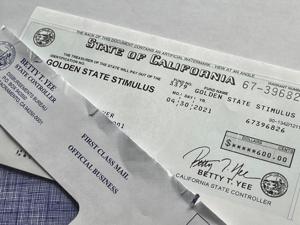Residents in multiple states receive additional stimulus checks through different state or local programs

(The Center Square) – Residents living in multiple states have received, or will receive by the end of the year, additional coronavirus-related stimulus funds either based on their income or as a bonus paid in appreciation of their services.
Most of the payments were authorized by state legislatures and funded through federal coronavirus relief money. The funds were administered by state or local authorities and differ from direct cash payments sent out by the U.S. Treasury Department.
Residents received some form of direct cash payments if they met eligibility requirements and filed their 2020 tax returns. Several states gave bonuses or retention payments to educators.
These payments exclude those issued by some states as incentives to get residents back to work, to retain nurses and healthcare workers, housing or other assistance, block grant funding for childcare workers, child tax credits, or payments to certain residents through universal basic income pilot programs.
In California, , in the first week of December, more than 800,000 Golden State Stimulus II payments were sent primarily to low-income residents. The payments will continue through Dec. 31, with eligible households receiving checks between $600 and $1,100.
The money was authorized in the state’s $100 billion budget Gov. Gavin Newsom signed in July. The state committed to distribute roughly $12 billion in coronavirus relief money to 15.2 million California households – or two-thirds of California taxpayers. California Franchise Tax Board officials said they expect roughly nine million checks to have been sent out by the end of the year.
“The Golden State Stimulus is key to lifting up those hit hardest by the pandemic and supporting California’s economic recovery, putting money directly in the hands of folks who will spend it on basic needs and within their local communities,” Newsom said when announcing the funding.
In Florida, the legislature also approved in its budget stimulus fund payments for first responders and law enforcement officers. Roughly 174,000 law-enforcement officers, fire-service personnel and emergency medical workers received a $1,000 payment. The state budget allocated $208.4 million as “a small token of appreciation” to “our first responders [who] worked tirelessly through the pandemic to meet the needs of our communities.”
Approximately, “49,405 sworn law enforcement officers, 40,732 EMTs [emergency medical technicians], 35,811 firefighters and 33,185 paramedics in Florida,” received a $1,000 bonus, Gov. Ron DeSantis’ office announced.
Educators also received $1,000 relief payments funded through the American Rescue Plan. The state used $215 million of federal funds to send payments to 175,000 full-time classroom teachers and more than 3,000 principals in Florida’s K-12 district schools, charter schools, and the Florida School for the Deaf and Blind.
Georgia educators also received $1,000 bonuses this year funded through $240 million worth of coronavirus relief money the state received. The state Board of Education approved the payments sent to teachers and most education employees earlier this year.
Several other states issued $1,000 “thank you” payments for working during the Covid-19 crisis. Michigan’s payments varied, with teachers receiving $500 bonuses in February, and those who worked inside school buildings received several thousand dollars worth of hazard pay.
In Detroit, as an incentive to motivate teachers to return to the classroom in the fall 2021 semester, teachers received $2,000 in hazard pay and an additional $2,000 if they taught a hybrid of in-person and online instruction.
In Tennessee, the legislature allocated funding for all school-based employees during the 2020-2021 school year with a one-time hazard pay bonus of $1,000 for full-time employees and $500 for part-time employees.
Other states and localities also implemented hazard pay schemes as an incentive for teachers to provide in-person instruction after having taught virtual learning for the previous year and in the wake of ongoing coronavirus fears and state lockdowns.
In New Mexico, the state legislature appropriated $5 million of federal relief money to provide one-time $750 cash payments to roughly 4,600 low-income New Mexican households that didn’t qualify for federal pandemic benefits.
In Maine, the state legislature approved sending $285 Disaster Relief checks to some residents within a certain income threshold “to support Maine people who worked amid the pandemic.” Payments were first sent out in mid-November, with roughly 500,000 residents expected to receive the funds by December 31.
Gov. Janet Mills says she hoped the payments would “help Maine families to some small degree during the holiday season as we work to fully recover our economy.”
In St. Louis, Missouri, thousands of residents had until Dec. 18 to apply for $500 Christmas stimulus checks. The city estimates there are at least 9,300 residents who would qualify, KSDK reported.
In Seattle, Washington, residents had until Nov. 15 to apply for stimulus payments worth up to $3,000. Through the Seattle Relief Fund, $16 million was allocated to help residents 18-years-old and older whose income is under 50% of the city’s median income. Eligibility requirements include applicants not qualifying to receive unemployment benefits, having no health insurance, and not having received a federal stimulus check.
Disclaimer: This content is distributed by The Center Square
